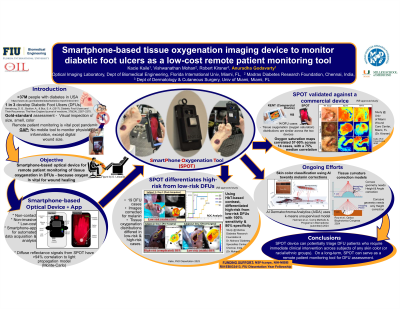Clinical Research
(CR-030) Smartphone-based tissue oxygenation imaging device to monitor diabetic foot ulcers as a low-cost remote patient monitoring tool

Telemedicine (TM) can revolutionize the impact of diabetic wound care management, along with tools for remote patient monitoring (RPM). There are no low-cost RPM devices for TM technology to provide comprehensive (visual and physiological) clinical assessments. Here, a novel low-cost smartphone-based optical imaging device was developed to provide physiological measurements of tissues in terms of tissue oxygenation distributions.
Methods:
: Our custom-developed device (SmartPhone Oxygenation Tool, SPOT) constitutes an add-on optical module, a smartphone, and a custom app to automate data acquisition while syncing multi-wavelength near-infrared light-emitting diode light source that illuminates the tissue and is detector by the smartphone’s camera. Tissue phantom and in-vivo validation studies were performed to assess the SPOT device’s capability to map tissue oxygenation changes as a non-contact imaging device. A melanin correction approach was developed to image across different skin colors (of varying racial/ethnic groups). SPOT device was used in a pilot study on 19 DFU cases to differentiate wounds that required immediate clinical intervention (high-risk) from those that did not (i.e., low-risk).
Results:
Tissue phantom validation studies correlated the optical maps by >96% when compared to gold-standard Monte Carlo-based light propagation models. Differences as small as 9% in tissue oxygenation were differentiable using the SPOT device. The SPOT device had a median correlation of 75% in oxygen saturation distributions compared with a commercial device across 14 DFU cases. Reconstructed melanin distributions correlated 91.6% across six simulated skin colors, thus making SPOT applicable to image across different skin colors. A pilot study on 19 DFU cases showed that a total hemoglobin-based contrast between the wound and periwound was a potential indicator to differentiate high-risk from low-risk DFUs with 100% sensitivity and 84% specificity.
Discussion: Our SPOT device can potentially triage DFU patients who require immediate clinical intervention across subjects of any skin color (or racial/ethnic groups). A smartphone app was also developed to transfer data via a secured cloud for clinicians to remotely assess the wound and intervene. Thus, our SPOT can serve as a smart health TM device for physiological RPM of DFUs objectively.

.jpeg)